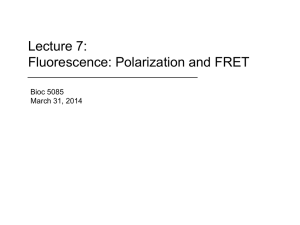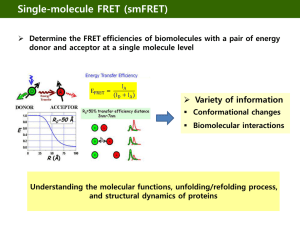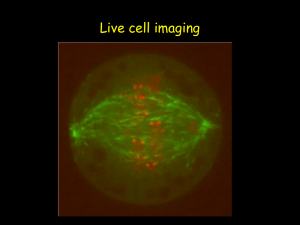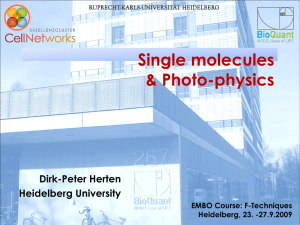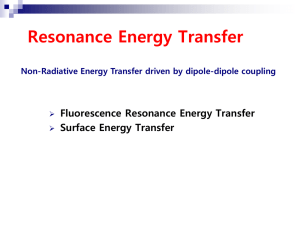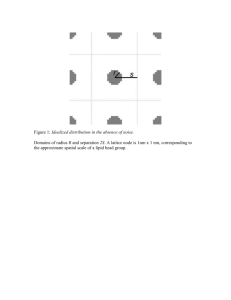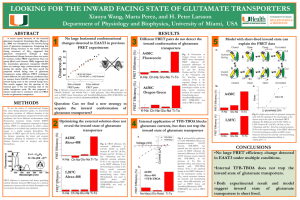SegregationFRET0515 - University of South Alabama
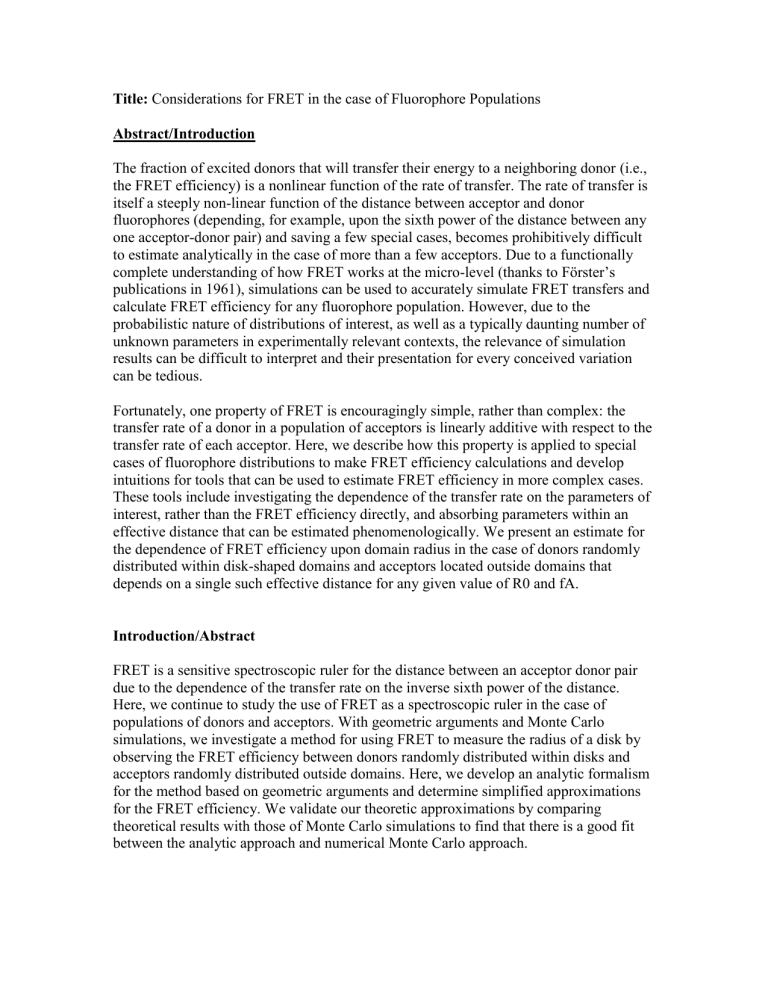
Title: Considerations for FRET in the case of Fluorophore Populations
Abstract/Introduction
The fraction of excited donors that will transfer their energy to a neighboring donor (i.e., the FRET efficiency) is a nonlinear function of the rate of transfer. The rate of transfer is itself a steeply non-linear function of the distance between acceptor and donor fluorophores (depending, for example, upon the sixth power of the distance between any one acceptor-donor pair) and saving a few special cases, becomes prohibitively difficult to estimate analytically in the case of more than a few acceptors. Due to a functionally complete understanding of how FRET works at the micro-level (thanks to Förster’s publications in 1961), simulations can be used to accurately simulate FRET transfers and calculate FRET efficiency for any fluorophore population. However, due to the probabilistic nature of distributions of interest, as well as a typically daunting number of unknown parameters in experimentally relevant contexts, the relevance of simulation results can be difficult to interpret and their presentation for every conceived variation can be tedious.
Fortunately, one property of FRET is encouragingly simple, rather than complex: the transfer rate of a donor in a population of acceptors is linearly additive with respect to the transfer rate of each acceptor. Here, we describe how this property is applied to special cases of fluorophore distributions to make FRET efficiency calculations and develop intuitions for tools that can be used to estimate FRET efficiency in more complex cases.
These tools include investigating the dependence of the transfer rate on the parameters of interest, rather than the FRET efficiency directly, and absorbing parameters within an effective distance that can be estimated phenomenologically. We present an estimate for the dependence of FRET efficiency upon domain radius in the case of donors randomly distributed within disk-shaped domains and acceptors located outside domains that depends on a single such effective distance for any given value of R0 and fA.
Introduction/Abstract
FRET is a sensitive spectroscopic ruler for the distance between an acceptor donor pair due to the dependence of the transfer rate on the inverse sixth power of the distance.
Here, we continue to study the use of FRET as a spectroscopic ruler in the case of populations of donors and acceptors. With geometric arguments and Monte Carlo simulations, we investigate a method for using FRET to measure the radius of a disk by observing the FRET efficiency between donors randomly distributed within disks and acceptors randomly distributed outside domains. Here, we develop an analytic formalism for the method based on geometric arguments and determine simplified approximations for the FRET efficiency. We validate our theoretic approximations by comparing theoretical results with those of Monte Carlo simulations to find that there is a good fit between the analytic approach and numerical Monte Carlo approach.
Fluorophore Distributions of Experimental Relevance
In the earliest applications of FRET, fluorophores were attached to locations on molecules and FRET was used as spectroscopic ruler for distances along the molecules.
Describe other examples? Depends if we want this to be more of a review.
Membrane Biology – Fluorophores Distribute Within and Around Domains
In lipid membrane biology, fluorophores are attached to molecules of interest and it is hoped that by comparing the observed FRET with expected outcomes for different distributions, more information about the distribution of the labeled molecules will be recovered. For example, for a given density of fluorophores, a FRET efficiency that is higher than expected for a homogeneous distribution indicates aggregation of fluorophores whereas a FRET efficiency that is lower than expected for a homogeneous distribution indicates regularity or separation across phases. An aggregated distribution would result in a higher FRET efficiency since molecules would have smaller minimum separations, while a regular distribution would result in a lower FRET efficiency since molecules are positioned to maximize their minimum inter-particle separations.
In many contexts, it is it is considered that fluorophores distribute randomly within domains. These domains may be small and compact, or comprise a signification fraction of the total membrane area and be connected. If donors and acceptors aggregate within a compartment, FRET efficiency will be higher compared to the case where fluorophores are distributed homoegenously throughout the membrane, whereas if they separate across compartments, FRET efficiency will be lower compared to the homogeneous case (fig, also see lourdes, fig X). We refer to FRET in the case of these distributions as intradomain FRET and segregation FRET respectively.
Intradomain FRET - Fluorophores distributed randomly within domains
With perfect partitioning, in the case of intradomain FRET, donors and acceptors partition together within domains. FRET efficiency will be higher compared to a homogeneous distribution because fluorophores are concentrated within domains. The extent of fluorophore concentration will depend upon the domain fraction. (A larger domain fraction will result in less concentration.) In (Kiskowski and Kenworthy, 2007) we studied intradomain FRET using Monte Carlo simulations and found that it robustly reports on the acceptor density within domains, and thus domain fraction. Intradomain
FRET generally will not report on the spatial scale of fluorophore containing domains since, for example, distributions with a single large domain or several medium sized domains with the same domain fraction would report the same local acceptor density within domains. To a small extent, one large domain may look different than many small domains due to 'edge' effects: donors located at the edge of a domain will not have a full neighborhood of acceptors surrounding them, and a random donor is more likely to be an edge donor in a small domain than a larger one.
Segregation FRET
A more straightforward means of using FRET as a ruler to measure the domain radius is to separate acceptors and donors across domains. With segregation FRET, reviewed by
Silvius and Nabi and Heberle et al ., donors may be assigned within an isolated domain fraction while acceptors are located in the connected region outside domains(Fig 2B) or donors may be assigned to the connected region outside isolated domains while acceptors are assigned within domains (Fig 2C). In either case, the method measures distances between a random donor and the closest acceptor to that donor so that the domain radius and the domain inter-distance are probed respectively.
We consider the problem of modeling the use of segregation FRET to determine domain radius when donors partition preferentially in a disk-shaped domains and acceptors preferentially partition in the connected complement. Various complications that can be considered are whether there can be incomplete separation of fluorophores among compartments, whether domains are disk-shaped and infinitely diluted, whether there is interaction between the two bi-layers, etc.
Generally: the FRET efficiency increases with acceptor density since with higher acceptor density, donors located at the domain edges interact with a higher density of acceptors. For domains that are small with respect to the Forster length, donors located at the edge of a domain will have a local acceptor density that is comparable to that of the acceptor-containing compartment and FRET efficiency is close to the FRET efficiency of acceptors homogenously distributed (in the limit of domains of radius 0).
A model for segregation FRET that accommodates many layers of complexity is that of
Towles et al (Biophys J, 2007). They present a model for time-resolved fluorescence decay for FRET among fluorophores with arbitrary partition coefficients in a bilayer.
They use simulations to generate exact results for the expected fluorescent decay and compare this with an analytic model in which the fluorescence decay is modeled as a function of the disk radius for a set of acceptor radial distribution functions generated from given chromofore partition coefficients, exclusion radii and an invariant Forster radius. Their analytic model is actually a hybrid model, because the RDFs are generated via simulations. According to the authors, the calculation of the RDFs is computationally intensive. They note that ... we suggest that the source of the error is [...], see appendix.
This can be mitigated by having 3 compartments.
1981 do x using a discrete lattice based method for small r and a continuous method for larger r, but find that the efficiency is diifucult to calculate because [...]. Instead of calculating the transfer rate by integrating over all the donor transer rates, we calculate the efficiency by integrating over all donors efficiency. (Notes this uses the property that the efficiency of an ensemble of donors is equally to the average of their individual effiiencies. Most donors within a domain will have zero efficiency -- or a small efficiency
--and those on the edge will have the higher efficiency.) Fortuitously, estimating the problem in this way resulted in an integral that could b solved analytically and which happened to have a surprising simple approximation.
Where indicated, we simulate FRET with a stochastic model based on that of Berney and
Danuser (29). The model simulates fluorophore excitation, decay and resonance transfer as stochastic processes and is described in detail in (Kiskowski and Kenworthy, 2007).
FRET for Populations of Fluorophores
1.
The Single Distance Model
The single distance model applies to a single acceptor-donor pair and was described by
Förster in 1949( 32 ) based on the transfer rate k t
from the donor to the acceptor that is expressed as a function of the separation distance R (for R in the 10- to 100-Å range), the donor lifetime
τ
D
, and the Förster distance
R
0
:
The donor lifetime τ
D
is the average length of time that a donor will remain excited before it decays spontaneously.
This is a probabilistic process and the probability that a donor will decay over a particular time interval is described by Poisson statistics. The inverse of the donor lifetime τ
D
is,
1
D
, is the decay rate.
Fig. X shows k
T
1
D
, the transfer rate normalized by the
R decay rate, verses
R
0
,the separation distance normalized by the Förster distance.
When the normalized separation distance is 1, the transfer rate is equal to the decay rate and half of excitations will transfer rather than decay. As the separation distance increases, the transfer rate will decrease slowly. As the separation distance decrease, the transfer rate will increase steeply.
The Förster distance
R
0
is the critical separation distance at which excitation transfer occurs with 50% probability over the lifetime of the donor and depends, among other things, on the spectral overlap of the fluorophores and the relative orientations of their transition dipoles during the energy transfer process.
The FRET efficiency E commonly used in FRET studies (Loura et al, 2010) is defined as fraction of donor excitations that result in transfer (the number of transfers divided by the total number of donor excitations) and depends in a straightforward way upon the transfer rate:
E = k t
/( k t
+ τ
D
) = E
1
r
1
R
0
6
.
Show a figure of the FRET efficiency verses the transfer rate and emphasize that any donor with a givenFRET efficiency is transferring at that rate, even in the case of multiple acceptors.
2.
Fixed Distance Model for 2, 3, or 4 Acceptors
In the case of multiple acceptors, the FRET efficiency is neither the sum nor the average of the individual FRET efficiencies between the donor and each acceptor, but is the result of an efficiency corresponding to the sum of the transfer rates: the rate of transfer from an excited donor to multiple acceptors separated at distances R i
is the sum of the individual transfer rates:
(valid assuming weak dipoledipole coupling, Förster, 1949)
I will then summarize calculations for FRET efficiency given 2, 3 or 4 acceptors at arbitrary distances (already in the universal curve/homoFRET paper).
Remark #1 : An illustration emphasizing that the transfer rate is additive but the efficiencies are not. Nevertheless, notice that the FRET efficiencies do map back to the donor transfer rate.
3.
Model for N Acceptors on a Ring – the transfer rate increases linearly with density
For example, consider a scenario in which a donor is neighbored by N acceptors at distance R .
The transfer rate would be N ·( R
0
6 / R 6 ) and the
FRET efficiency would be 1/(1+(1/ N
)·(
R
6
/ R
0
6
)).
The non-linear effect of increasing the number of acceptors in this scenario can be seen in Fig X.
Note that when the FRET efficiency with acceptors individually is small, the effect of the number of acceptors is approximately additive
(linear) while this becomes increasingly less true if each acceptor would independently foster a high efficiency.
I will show a plot of transfer rate verses N, which simply increases linearly.
4.
Model for N Acceptors in a Ring – the transfer rate does not increases linearly with density
When the acceptors are distributed with random distances around a donor, the transfer rate – while additive – does not increase linearly with particle density. (This is what tripped me up in this paper, I’ve sorted out now that I was just wrong in this assumption.)
5.
Model for Homogeneously Distributed Acceptors in an Infinite Domain – the convenient analytic approximation of Wolber and Hudson
I think that there is a natural transition from N acceptors randomly in a disk to the homeogenous distribution (you just consider R
infinity and point out that the radius of interaction isn’t much larger than 2Ro.
I don’t have much to add besides reminding people that there is this nice analytic estimate. I could give some details (2 sentences) on how to apply it and if Mark helps me
I could explain the Fung and Stryer derivation (Mark says this is necessary because even a particle physicist couldn’t figure out what they were doing, but they refer back to
Förster’s paper which presumably has the necessary details.)
6.
Generalized Acceptor Distributions: A Small Neighborhood of Interaction
The FRET efficiency is a result that, like the transfer rate, must depend upon the distance between the donor and the acceptor raised to the sixth power. Since the FRET efficiency decreases at a rate proportional to the distance normalized by R
0
to the 6 th power, the
Förster distance determines a neighborhood of transfer interaction of approximately 2
Förster lengths. At 2 Förster lengths, transfer efficiency would already be reduced to 2%.
Thus, donors will interact with acceptors within this radius of 2 R
0
, and will interact negligibly with acceptors outside this radius.
When considering the interaction of populations of donors and acceptors, one need only consider a neighborhood of radius 2 R
0
around each donor.
7.
Generalized Acceptor Donor Distributions: Competition for Acceptors and the
Effect of Multiple Donors
In the case of multiple donors, donors may find themselves competing for the same acceptors (note that a donor can even compete with itself) but this can be mitigated by using a low intensity so that multiple donors are unlikely to be active in the same neighborhood.
Sober complications arise when you consider that multiple donors will have difference environments. I will include one figure only for a 3 particle system with two configuration (one donor and 2 acceptors) illustrating that the final FRET efficiency does
NOT depend upon the average distribution of acceptors and does not even depend on the average transfer rate – the final FRET efficiency is the average of the two individual
FRET efficiencies!
8.
Developing a FRET tool: Effective Distance
For example, consider a scenario in which a donor is neighbored by N acceptors at distance R .
We observe that regardless of the number of acceptors in the neighborhood of a donor, the
FRET efficiency is always less than 100%. This means that the FRET efficiency of a donor in any acceptor neighborhood can be modeled by the
FRET efficiency between a donor and a single acceptor at specific distance. This motivates the definition of an effective donor acceptor distance
R eff
of a donor neighborhood as the distance between a donor and the single acceptor that would yield the same FRET efficiency.
We can look at how this effective distance varies
(a) as the distance increases with the single distance model compared to a pair of acceptors
(b) as we increase the number of particles in a ring
(c) as we increase the density of particles in a disk
We use this tool to approximate FRET efficiency verses domain radius in the case of segregation FRET, and use simulations to verify the usefulness of the approximation.
E
1
D eff
R
0
6
9.
Applying Effective Distance to Approximating segregation FRET as a function of domain radius
Consider the segregation FRET fluorophore distribution in which donors are located randomly within disk-shaped domains of radius R and interact with acceptors located outside domains. Using geometric arguments and Monte Carlo methods to estimate the effective donor-acceptor separation distance s , we find that the segregation FRET efficiency Ē can be estimated analytically by:
E
1
R
2
R
0
1
2
rdr
R
r
R
0
s
6 where (R-r) is the distance of the donor from the domain center. The simplicity of this estimate provides the following interpretation: for the approximation of Ē, a simplifying assumption can be made that each donor within the domain interacts with the population of acceptors as if the population of acceptors were replaced with a single acceptor located a distance s from the edge of the domain. the FRET efficiency of donor molecules randomly located within the domain and a single acceptor molecule located an effective distance s from the domain boundary.
Development of the Approximation:
Consider the disk partitioned into shells of radius r and width dr . The FRET efficiency Ē of donors in the disk would be the average of the FRET efficiency in each shell weighted by the number of donors in each shell.
Let E ( r ) be the average FRET efficiency of donors in a shell of radius r (0< r < R ) populated at density δ.
Then Ē would be the sum of FRET efficiencies within each shell divided by the sum of donors in each shell:
E
R
0
E
2
rdr
R
0
2
rdr
1
R
2
R
0
E
2
rdr
For each shell S ( r ), there is an effective distance D eff
( r ) that yields the average FRET efficiency E ( r ) of that shell. Using Equation X, we have:
E
1
R
2
R
0
2
rdr
1
D eff
R
0
( r )
6
.
We use Monte Carlo simulations to determine D eff
( r ) as a function of the radius r from the disk center as a function of the domain radius R , the acceptor density f
A
outside the domains and the Förster length R
0
.
Within each shell, all donors are equidistant from the domain edge. Given our previous analyses, we know that D r may be a complex function of r / may be a linear function of r and we investigate this with Monte Carlo methods to find that D r
increases approximately linearly with respect to R-r for the range over which the contribution to FRET efficiency would be nonnegligible. Notably, the effective distance does not depend on the domain radius (the figure shows effective distance for domains varying from 5 to 60 nm). Thus substituting D r
= Rr+s we have:
E
1
R 2
R
0
1
2
rdr
R
r
R
0
s
6
.
This integral can be solved explicitly (for example, using Mathematica
online integrator).
The value of the integral for different values of R0 as the distance R ranges from 0 to 65 and s=0 is shown with the black lines in the figure. This integral has several complex terms involving logarithms and arctan functions, but can be approximated very well for R>>Ro by the simple function E=
1
5
R
R
0 when s = 0 (see Fig, red lines).
For general s (see Figure to be added), the dependence of FRET efficiency upon distance
R is fit very well by
1
b
5
R
R
0 where b is a free parameter chosen to fit the curve.
Discussion: This analysis depended upon having knowledge of the effective distance as a function of shell radius. In this case, we used Monte Carlo methods to determine the effective distance and found that the effective distance was approximately linear. The effective distance need not have been so simple, a more complex function of r could have been used as well. However, in the latter case the integral may not be explicitly solvable as this was and may require numerical integration.
Validation: Comparison with Monte Carlo Simulations of Segregation FRET
We use the analytic approximation for segregation FRET to estimate FRET efficiency verses domain radius for different Forster lengths and acceptor densities. This requires using MC simulations to generate effective distances as a function of Forster length and acceptor density. As noted, the effective distance is a function of the distance of the shell from the domain edge but does not depend on the domain radius. These values are shown in Figures 1a and 1b. The FRET efficiency verses domain radius for varying Forster length and acceptor densities are shown in Figures 1c and 1d (red lines). Consistent with other MC and hybrid analyses, the FRET efficiency decreases with the domain radius, increases with the Forster length, and increases with the acceptor density. (see Fig, red lines). Further, we overlay the results of Monte Carlo simulations for these parameters and find a close match (black lines).
Effective distance of shell verses distance from disk center as a function of Forster length when fA=0.05. (Can be approximated as a family of lines.)
Effective distance of shell verses distance from disk center as a function of acceptor density when Ro=3.5. (Can be approximated as a family of lines.)
Red lines show the result of the analytic approximation. Black lines show the average and standard error of MC model over 5 simulations. (I will switch colors on Monday.)
Discussion
Somewhere I need to describe the math that Towles used. They provide an estimate valid for R<<4Ro while our estimate is valid for R>>R0. Loura et als review, page about analytic formalism, is a good thing to read for how this relates to the literature.
Explicit Verses Analytic Models
Explicit, simulation-based models and analytic models of FRET present distinct advantages and challenges, and share in common the need to accurately represent the relevant physics and geometry of their application. Simulation models may be computationally intensive, but can accommodate virtually unlimited model complexity.
Additional factors and interactions can be added without altering the tractability of the model; indeed they often do not even increase the computational intensity but find limits only in the detail of our knowledge of the physics. Since the interacting particles and their interactions are explicit, simulation results are quite accurate. The chief drawback of simulations is that since all interactions are explicit, the outcome of a simulation is specific to that set of interactions and it can be challenging to draw general inferences.
Parameters and interactions may not be known at the level of detail required for the simulation, or may be expected to vary among applications, which introduces error or reduced applicability if general inferences are not made. With increasing model complexity, it can be difficult to interpret and present simulation results over the range of relevant parameters. In implementation, it can be difficult to verify that the physics that was modeled as intended. (There can be ‘bugs’ in the code and concerns with respect to systematic non-random effects and artifacts.) In contrast, analytic models are more transparent regarding the way the physics is implemented and their chief advantage is that, once developed, an analytic model can be used to make rigorous and useful inferences about the model. The main challenge of analytic models is that added complexity quickly makes a problem intractable. Given that an analytic model is tractable, there are advantages for complex and simplified models alike. An analytic model that represents the complexity of a real system yields results that are especially relevant, an analytic model that represents a simplified system is especially easy to interpret and draw general inferences.
Analytic models and simulation based models can be used to buttress one another, and are often presented together in pairs in the use of modeling to study an application. Since simulations can accurately represent the relevant layers of complexity, they can be used to check an analytic model, to ensure that the simplifications of the analytic model are justified and establish parameter ranges for the applicability of the analytic model over which the analytic simplifications are appropriate. The analytic model, in turn, enables rigorous inference about the system being modeled and provides transparency regarding the physical assumptions that are being made.
Quick Guide to Model Assumptions
The simplifying assumptions that are made in the analytic analysis can be separated into two classes. In the first class are assumptions that are made regarding the distribution of molecules within domains. We assume that domains are perfectly disk-shaped, domains do not interact and donors partition exclusively within domains and acceptors partition exclusively and homogenously outside domains. These assumptions apply to both the analytic formalism and the Monte Carlo model and are used to reduce the number of variables being studied. While it is not expected that these assumptions are representative of any experimental scenario, they represent a point of departure from which to understand and characterize the use of segregation FRET to measure domain size. In the second class are approximations that are made to make the analytic formalism tractable: namely, modeling the effect of a population of acceptors with a single effective distance
R eff
and assuming that donors and acceptors are point particles distributed homogeneously throughout their compartments. Since the Monte Carlo model does not make these assumptions – particles are distributed randomly rather than homogeneously and are assumed to have a finite exclusion radius – comparison of the analytic results and the
Monte Carlo simulations can be used to determine the magnitude of those effects.

